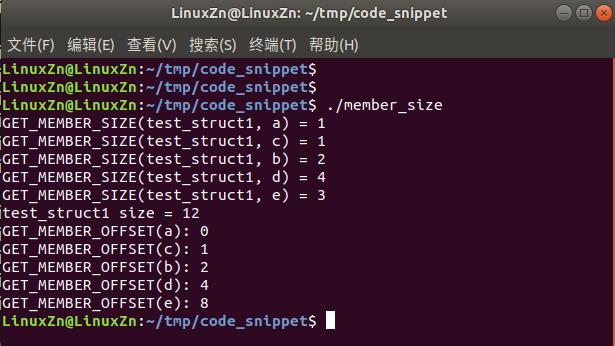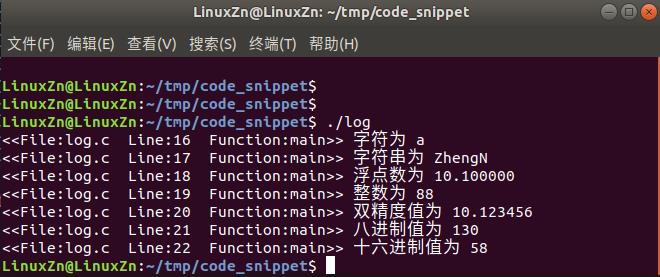分享几个实用的代码片段(第二弹)
Posted 嵌入式大杂烩
tags:
篇首语:本文由小常识网(cha138.com)小编为大家整理,主要介绍了分享几个实用的代码片段(第二弹)相关的知识,希望对你有一定的参考价值。
大家好,我是杂烩君。
本次我们再来分享几个实用的代码小片段。
快速获取结构体成员大小
获取结构体成员大小及偏移量的方式有多种。最简便的方式:
代码:
左右滑动查看全部代码>>>
// 微信公众号:嵌入式大杂烩
#include <stdio.h>
// 获取结构体成员大小
#define GET_MEMBER_SIZE(type, member) sizeof(((type*)0)->member)
// 获取结构体成员偏移量
#define GET_MEMBER_OFFSET(type, member) ((size_t)(&(((type*)0)->member)))
typedef struct _test_struct0
char x;
char y;
char z;
test_struct0;
typedef struct _test_struct1
char a;
char c;
short b;
int d;
test_struct0 e;
test_struct1;
int main(int arc, char *argv[])
printf("GET_MEMBER_SIZE(test_struct1, a) = %ld\\n", GET_MEMBER_SIZE(test_struct1, a));
printf("GET_MEMBER_SIZE(test_struct1, c) = %ld\\n", GET_MEMBER_SIZE(test_struct1, c));
printf("GET_MEMBER_SIZE(test_struct1, b) = %ld\\n", GET_MEMBER_SIZE(test_struct1, b));
printf("GET_MEMBER_SIZE(test_struct1, d) = %ld\\n", GET_MEMBER_SIZE(test_struct1, d));
printf("GET_MEMBER_SIZE(test_struct1, e) = %ld\\n", GET_MEMBER_SIZE(test_struct1, e));
printf("test_struct1 size = %ld\\n", sizeof(test_struct1));
printf("GET_MEMBER_OFFSET(a): %ld\\n", GET_MEMBER_OFFSET(test_struct1, a));
printf("GET_MEMBER_OFFSET(c): %ld\\n", GET_MEMBER_OFFSET(test_struct1, c));
printf("GET_MEMBER_OFFSET(b): %ld\\n", GET_MEMBER_OFFSET(test_struct1, b));
printf("GET_MEMBER_OFFSET(d): %ld\\n", GET_MEMBER_OFFSET(test_struct1, d));
printf("GET_MEMBER_OFFSET(e): %ld\\n", GET_MEMBER_OFFSET(test_struct1, e));
return 0;
运行结果:

文件操作
文件操作平时用得很多,为了方便使用,可以自己根据实际需要再封装一层:
代码:
左右滑动查看全部代码>>>
// 微信公众号:嵌入式大杂烩
#include <stdio.h>
static int file_opt_write(const char *filename, void *ptr, int size)
FILE *fp;
size_t num;
fp = fopen(filename, "wb");
if(NULL == fp)
printf("open %s file error!\\n", filename);
return -1;
num = fwrite(ptr, 1, size, fp);
if(num != size)
fclose(fp);
printf("write %s file error!\\n", filename);
return -1;
fclose(fp);
return num;
static int file_opt_read(const char *filename, void *ptr, int size)
FILE *fp;
size_t num;
fp = fopen(filename, "rb");
if(NULL == fp)
printf("open %s file error!\\n", filename);
return -1;
num = fread(ptr, 1, size, fp);
if(num != size)
fclose(fp);
printf("write %s file error!\\n", filename);
return -1;
fclose(fp);
return num;
typedef struct _test_struct
char a;
char c;
short b;
int d;
test_struct;
int main(int arc, char *argv[])
#define FILE_NAME "./test_file"
test_struct write_data = 0;
write_data.a = 1;
write_data.b = 2;
write_data.c = 3;
write_data.d = 4;
printf("write_data.a = %d\\n", write_data.a);
printf("write_data.b = %d\\n", write_data.b);
printf("write_data.c = %d\\n", write_data.c);
printf("write_data.d = %d\\n", write_data.d);
file_opt_write(FILE_NAME, (test_struct*)&write_data, sizeof(test_struct));
test_struct read_data = 0;
file_opt_read(FILE_NAME, (test_struct*)&read_data, sizeof(test_struct));
printf("read_data.a = %d\\n", read_data.a);
printf("read_data.b = %d\\n", read_data.b);
printf("read_data.c = %d\\n", read_data.c);
printf("read_data.d = %d\\n", read_data.d);
return 0;
运行结果:

进度条
有时候,加上进度条可以比较方便知道当前的下载进度、写入文件的进度等。
代码:
左右滑动查看全部代码>>>
// 微信公众号:嵌入式大杂烩
#include <stdio.h>
#include <string.h>
#include <unistd.h>
typedef struct _progress
int cur_size;
int sum_size;
progress_t;
void progress_bar(progress_t *progress_data)
int percentage = 0;
int cnt = 0;
char proc[102];
memset(proc, '\\0', sizeof(proc));
percentage = (int)(progress_data->cur_size * 100 / progress_data->sum_size);
printf("percentage = %d %%\\n", percentage);
if (percentage <= 100)
while (cnt <= percentage)
printf("[%-100s] [%d%%]\\r", proc, cnt);
fflush(stdout);
proc[cnt] = '#';
usleep(100000);
cnt++;
printf("\\n");
int main(int arc, char *argv[])
progress_t progress_test = 0;
progress_test.cur_size = 65;
progress_test.sum_size = 100;
progress_bar(&progress_test);
return 0;
运行结果:


日志输出
日志输出常常需要带一些格式。最简单的方式如:
代码:
左右滑动查看全部代码>>>
// 微信公众号:嵌入式大杂烩
#include <stdio.h>
#define LOG_D(fmt, args...) do\\
\\
printf("<<File:%s Line:%d Function:%s>> ", __FILE__, __LINE__, __FUNCTION__);\\
printf(fmt, ##args);\\
while(0)
int main(int arc, char *argv[])
char ch = 'a';
char str[10] = "ZhengN";
float float_val = 10.10;
int num = 88;
double double_val = 10.123456;
LOG_D("字符为 %c \\n", ch);
LOG_D("字符串为 %s \\n" , str);
LOG_D("浮点数为 %f \\n", float_val);
LOG_D("整数为 %d\\n" , num);
LOG_D("双精度值为 %lf \\n", double_val);
LOG_D("八进制值为 %o \\n", num);
LOG_D("十六进制值为 %x \\n", num);
return 0;
运行结果:

可阅读往期文章:
后台运行生成core文件
这个是我们上一篇文章分享一种你可能不知道的bug定位方法介绍的,方便大家使用,也汇总在这里。
代码:
左右滑动查看全部代码>>>
// 微信公众号:嵌入式大杂烩
#include <stdio.h>
#include <stdlib.h>
#include <sys/time.h>
#include <sys/resource.h>
#define SHELL_CMD_CONF_CORE_FILE "echo /var/core-%e-%p-%t > /proc/sys/kernel/core_pattern"
#define SHELL_CMD_DEL_CORE_FILE "rm -f /var/core*"
static int enable_core_dump(void)
int ret = -1;
int resource = RLIMIT_CORE;
struct rlimit rlim;
rlim.rlim_cur = 1 ? RLIM_INFINITY : 0;
rlim.rlim_max = 1 ? RLIM_INFINITY : 0;
system(SHELL_CMD_DEL_CORE_FILE);
if (0 != setrlimit(resource, &rlim))
printf("setrlimit error!\\n");
return -1;
else
system(SHELL_CMD_CONF_CORE_FILE);
printf("SHELL_CMD_CONF_CORE_FILE\\n");
return 0;
return ret;
int main(int argc, char **argv)
enable_core_dump();
printf("==================segmentation fault test==================\\n");
int *p = NULL;
*p = 1234;
return 0;
以上就是本次分享的几个小的代码片段。
期待你的三连支持!
注意
由于微信公众号近期改变了推送规则,如果您想经常看到我们的文章,可以在每次阅读后,在页面下方点一个「赞」或「在看」,这样每次推送的文章才会第一时间出现在您的订阅列表里。
猜你喜欢:
在公众号聊天界面回复1024,可获取嵌入式资源;回复 m ,可查看文章汇总
以上是关于分享几个实用的代码片段(第二弹)的主要内容,如果未能解决你的问题,请参考以下文章